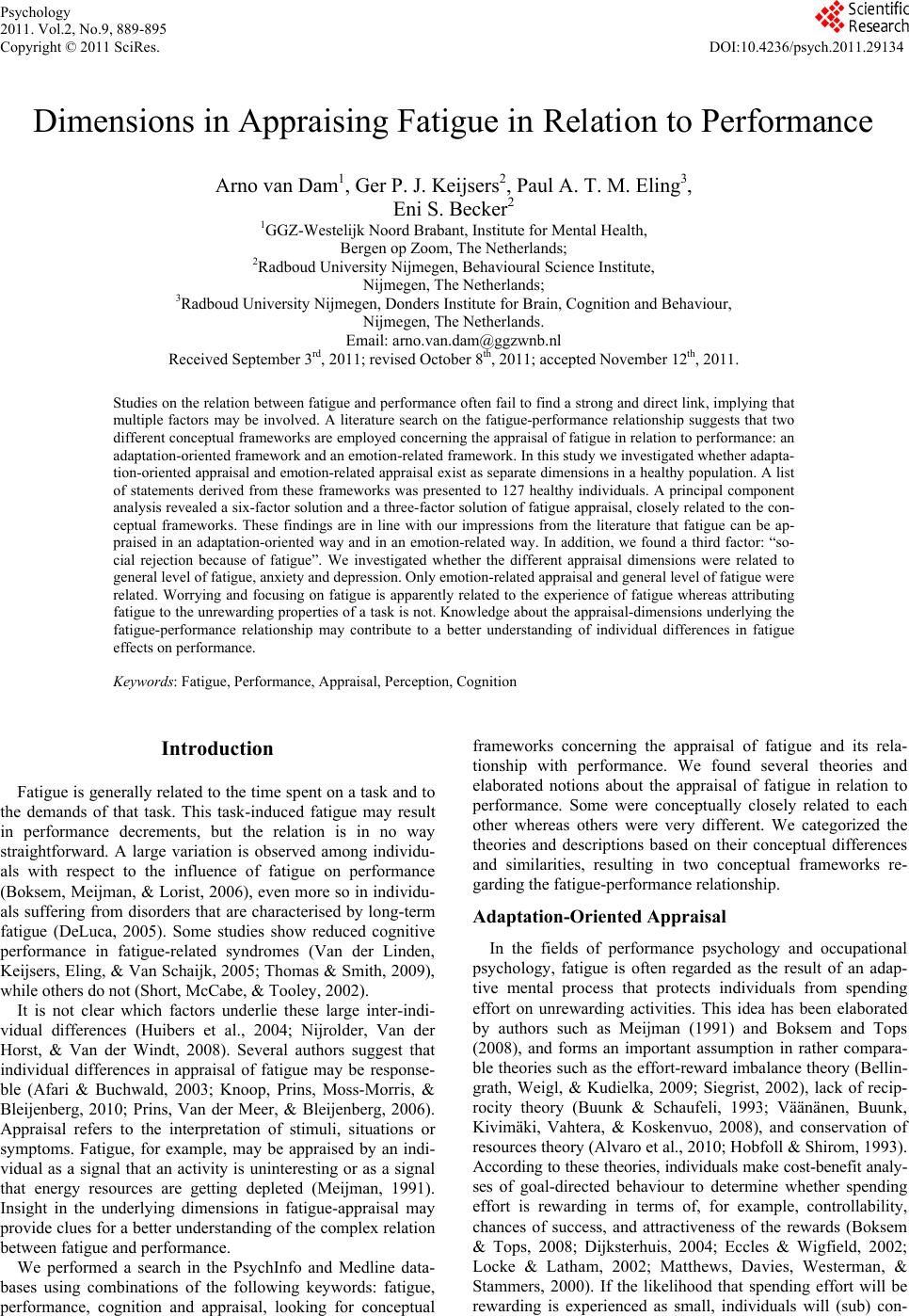 Psychology 2011. Vol.2, No.9, 889-895 Copyright © 2011 SciRes. DOI:10.4236/psych.2011.29134 Dimensions in Appraising Fatigue in Relation to Performance Arno van Dam1, Ger P. J. Keijsers2, Paul A. T. M. Eling3, Eni S. Becker2 1GGZ-Westelijk Noord Brabant, Institute for Mental Health, Bergen op Zoom, The Netherlands; 2Radboud University Nijmegen, Behavioural Science Institute, Nijmegen, The Netherlands; 3Radboud University Nijmegen, Donders Institute for Brain, Cognition and Behaviour, Nijmegen, The Netherlands. Email: arno.van.dam@ggzwnb.nl Received September 3rd, 2011; revised October 8th, 2011; accepted November 12th, 2011. Studies on the relation between fatigue and performance often fail to find a strong and direct link, implying that multiple factors may be involved. A literature search on the fatigue-performance relationship suggests that two different conceptual frameworks are employed concerning the appraisal of fatigue in relation to performance: an adaptation-oriented framework and an emotion-related framework. In this study we investigated whether adapta- tion-oriented appraisal and emotion-related appraisal exist as separate dimensions in a healthy population. A list of statements derived from these frameworks was presented to 127 healthy individuals. A principal component analysis revealed a six-factor solution and a three-factor solution of fatigue appraisal, closely related to the con- ceptual frameworks. These findings are in line with our impressions from the literature that fatigue can be ap- praised in an adaptation-oriented way and in an emotion-related way. In addition, we found a third factor: “so- cial rejection because of fatigue”. We investigated whether the different appraisal dimensions were related to general level of fatigue, anxiety and depression. Only emotion-related appraisal and general le vel o f f at ig u e we re related. Worrying and focusing on fatigue is apparently related to the experience of fatigue whereas attributing fatigue to the unrewarding properties of a task is not. Knowledge about the appraisal-dimensions underlying the fatigue-performance relationship may contribute to a better understanding of individual differences in fatigue effects on performance. Keywords: Fatigue, Performance, Appraisal, Perception, C o g n i ti o n Introduction Fatigue is generally related to the time spent on a task and to the demands of that task. This task-induced fatigue may result in performance decrements, but the relation is in no way straightforward. A large variation is observed among individu- als with respect to the influence of fatigue on performance (Boksem, Meijman, & Lorist, 2006), even more so in individu- als suffering from disorders that are characterised by long-term fatigue (DeLuca, 2005). Some studies show reduced cognitive performance in fatigue-related syndromes (Van der Linden, Keijsers, Eling, & Van Schaijk, 2005; Thomas & Smith, 2009), while others do not (Short, McCabe, & Tooley, 2002). It is not clear which factors underlie these large inter-indi- vidual differences (Huibers et al., 2004; Nijrolder, Van der Horst, & Van der Windt, 2008). Several authors suggest that individual differences in appraisal of fatigue may be response- ble (Afari & Buchwald, 2003; Knoop, Prins, Moss-Morris, & Bleijenberg, 2010; Prins, Van der Meer, & Bleijenberg, 2006). Appraisal refers to the interpretation of stimuli, situations or symptoms. Fatigue, for example, may be appraised by an indi- vidual as a signal that an activity is uninteresting or as a signal that energy resources are getting depleted (Meijman, 1991). Insight in the underlying dimensions in fatigue-appraisal may provide clues for a better understanding of the complex relation between fatigue and performance. We performed a search in the PsychInfo and Medline data- bases using combinations of the following keywords: fatigue, performance, cognition and appraisal, looking for conceptual frameworks concerning the appraisal of fatigue and its rela- tionship with performance. We found several theories and elaborated notions about the appraisal of fatigue in relation to performance. Some were conceptually closely related to each other whereas others were very different. We categorized the theories and descriptions based on their conceptual differences and similarities, resulting in two conceptual frameworks re- garding the fatigue-performance relationship. Adaptation-Oriented Ap praisal In the fields of performance psychology and occupational psychology, fatigue is often regarded as the result of an adap- tive mental process that protects individuals from spending effort on unrewarding activities. This idea has been elaborated by authors such as Meijman (1991) and Boksem and Tops (2008), and forms an important assumption in rather compara- ble theories such as the effort-reward imbalance theory (Bellin- grath, Weigl, & Kudielka, 2009; Siegrist, 2002), lack of recip- rocity theory (Buunk & Schaufeli, 1993; Väänänen, Buunk, Kivimäki, Vahtera, & Koskenvuo, 2008), and conservation of resources theory (Alvaro et al., 2010; Hobfoll & Shirom, 1993). According to these theories, individuals make cost-benefit analy - ses of goal-directed behaviour to determine whether spending effort is rewarding in terms of, for example, controllability, chances of success, and attractiveness of the rewards (Boksem & Tops, 2008; Dijksterhuis, 2004; Eccles & Wigfield, 2002; Locke & Latham, 2002; Matthews, Davies, Westerman, & Stammers, 2000). If the likelihood that spending effort will be rewarding is experienced as small, individuals will (sub) con- 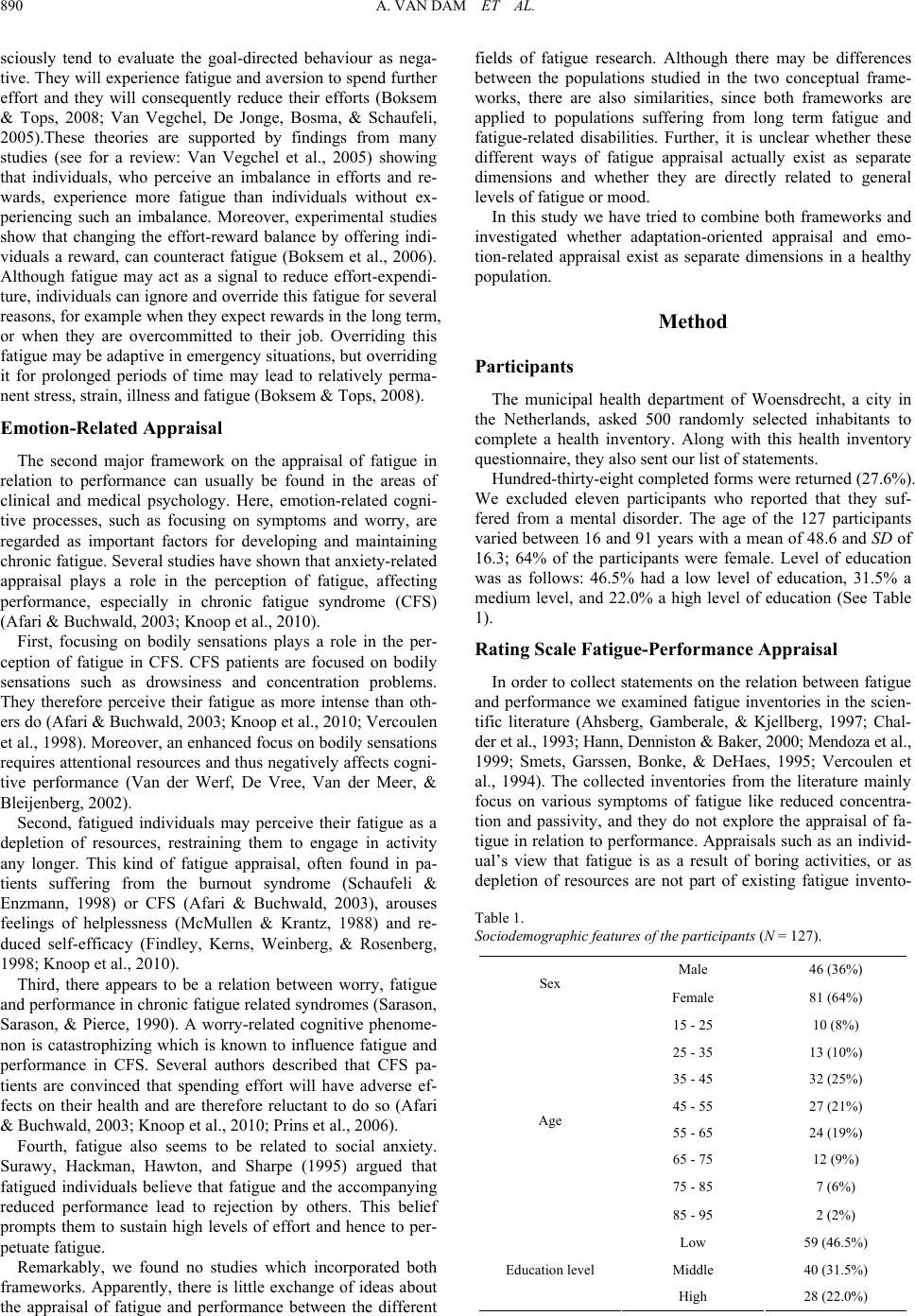 A. VAN DAM ET AL. 890 sciously tend to evaluate the goal-directed behaviour as nega- tive. They will experience fatigue and aversion to spend further effort and they will consequently reduce their efforts (Boksem & Tops, 2008; Van Vegchel, De Jonge, Bosma, & Schaufeli, 2005).These theories are supported by findings from many studies (see for a review: Van Vegchel et al., 2005) showing that individuals, who perceive an imbalance in efforts and re- wards, experience more fatigue than individuals without ex- periencing such an imbalance. Moreover, experimental studies show that changing the effort-reward balance by offering indi- viduals a reward, can counteract fatigue (Boksem et al., 2006). Although fatigue may act as a signal to reduce effort-expendi- ture, individuals can ignore and override this fatigue for several reasons, for example when they expect rewards in the long term, or when they are overcommitted to their job. Overriding this fatigue may be adaptive in emergency situations, but overriding it for prolonged periods of time may lead to relatively perma- nent stress, strain, illness and fatigue (Boksem & Tops, 2008). Emotion-Related Appraisal The second major framework on the appraisal of fatigue in relation to performance can usually be found in the areas of clinical and medical psychology. Here, emotion-related cogni- tive processes, such as focusing on symptoms and worry, are regarded as important factors for developing and maintaining chronic fatigue. Several studies have shown that anxiety-related appraisal plays a role in the perception of fatigue, affecting performance, especially in chronic fatigue syndrome (CFS) (Afari & Buchwald, 2003; Knoop et al., 2010). First, focusing on bodily sensations plays a role in the per- ception of fatigue in CFS. CFS patients are focused on bodily sensations such as drowsiness and concentration problems. They therefore perceive their fatigue as more intense than oth- ers do (Afari & Buchwald, 2003; Knoop et al., 2010; Vercoulen et al., 1998). Moreover, an enhanced focus on bodily sensations requires attentional resources and thus negatively affects cogni- tive performance (Van der Werf, De Vree, Van der Meer, & Bleijenberg, 2002). Second, fatigued individuals may perceive their fatigue as a depletion of resources, restraining them to engage in activity any longer. This kind of fatigue appraisal, often found in pa- tients suffering from the burnout syndrome (Schaufeli & Enzmann, 1998) or CFS (Afari & Buchwald, 2003), arouses feelings of helplessness (McMullen & Krantz, 1988) and re- duced self-efficacy (Findley, Kerns, Weinberg, & Rosenberg, 1998; Knoop et al., 2010). Third, there appears to be a relation between worry, fatigue and performance in chronic fatigue related syndromes (Sarason, Sarason, & Pierce, 1990). A worry-related cognitive phenome- non is catastrophizing which is known to influence fatigue and performance in CFS. Several authors described that CFS pa- tients are convinced that spending effort will have adverse ef- fects on their health and are therefore reluctant to do so (Afari & Buchwald, 2003; Knoop et al., 2010; Prins et al., 2006). Fourth, fatigue also seems to be related to social anxiety. Surawy, Hackman, Hawton, and Sharpe (1995) argued that fatigued individuals believe that fatigue and the accompanying reduced performance lead to rejection by others. This belief prompts them to sustain high levels of effort and hence to per- petuate fatigue. Remarkably, we found no studies which incorporated both frameworks. Apparently, there is little exchange of ideas about the appraisal of fatigue and performance between the different fields of fatigue research. Although there may be differences between the populations studied in the two conceptual frame- works, there are also similarities, since both frameworks are applied to populations suffering from long term fatigue and fatigue-related disabilities. Further, it is unclear whether these different ways of fatigue appraisal actually exist as separate dimensions and whether they are directly related to general levels of fatigue or mood. In this study we have tried to combine both frameworks and investigated whether adaptation-oriented appraisal and emo- tion-related appraisal exist as separate dimensions in a healthy population. Method Participants The municipal health department of Woensdrecht, a city in the Netherlands, asked 500 randomly selected inhabitants to complete a health inventory. Along with this health inventory questionnaire, they also sent our list of statements. Hundred-thirty-eight completed forms were returned (27.6%). We excluded eleven participants who reported that they suf- fered from a mental disorder. The age of the 127 participants varied between 16 and 91 years with a mean of 48.6 and SD of 16.3; 64% of the participants were female. Level of education was as follows: 46.5% had a low level of education, 31.5% a medium level, and 22.0% a high level of education (See Table 1). Rating Scale Fatigue-Performance Appraisal In order to collect statements on the relation between fatigue and performance we examined fatigue inventories in the scien- tific literature (Ahsberg, Gamberale, & Kjellberg, 1997; Chal- der et al., 1993; Hann, Denniston & Baker, 2000; Mendoza et a l., 1999; Smets, Garssen, Bonke, & DeHaes, 1995; Vercoulen et al., 1994). The collected inventories from the literature mainly focus on various symptoms of fatigue like reduced concentra- tion and passivity, and they do not explore the appraisal of fa- tigue in relation to performance. Appraisals such as an individ- ual’s view that fatigue is as a result of boring activities, or as depletion of resources are not part of existing fatigue invento- Table 1. Sociodemographic featur es of the participants (N = 127). Male 46 (36%) Sex Female 81 (64%) 15 - 25 10 (8%) 25 - 35 13 (10%) 35 - 45 32 (25%) 45 - 55 27 (21%) 55 - 65 24 (19%) 65 - 75 12 (9%) 75 - 85 7 (6%) Age 85 - 95 2 (2%) Low 59 (46.5%) Middle 40 (31.5%) Education level High 28 (22.0%) 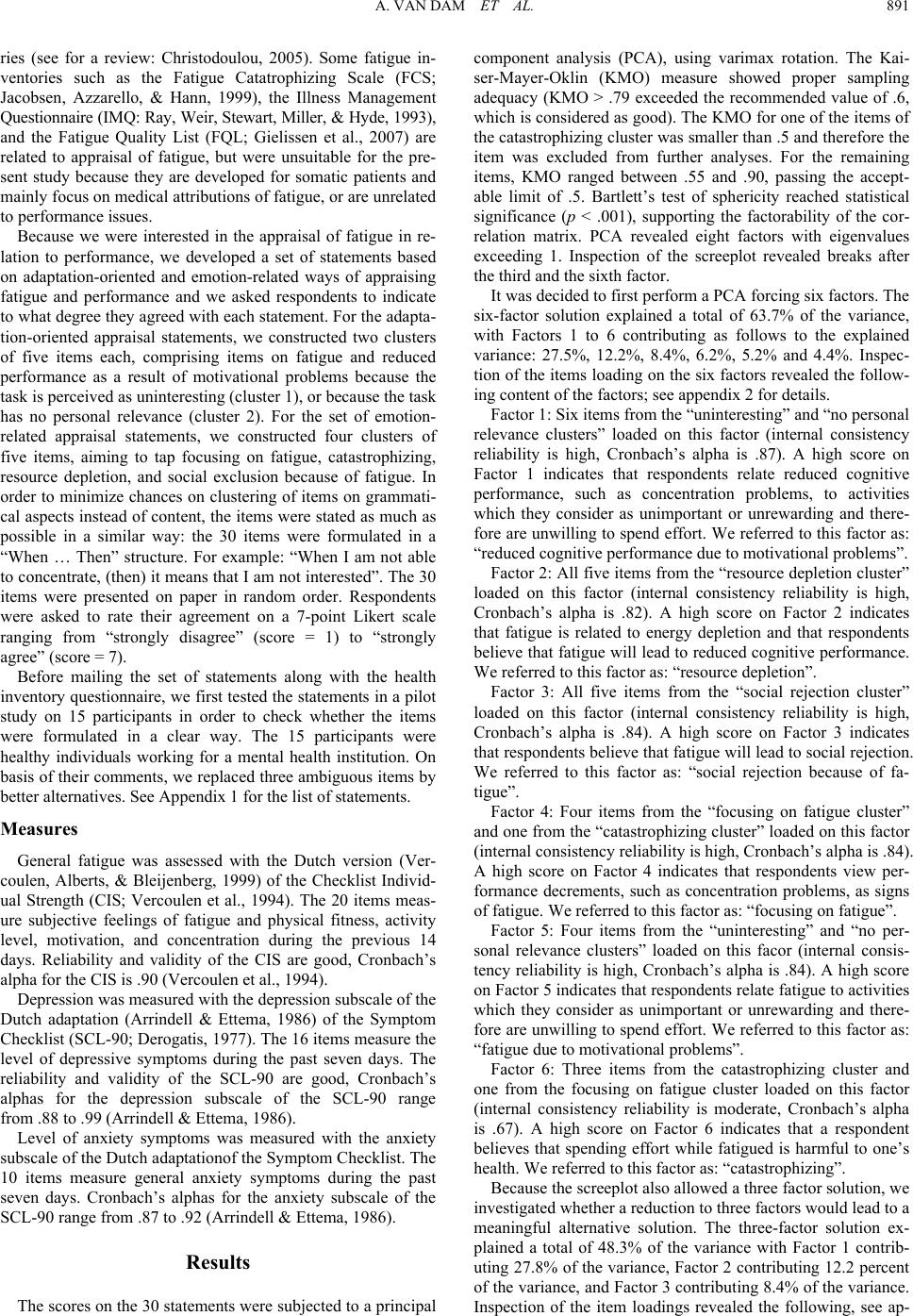 A. VAN DAM ET AL. 891 ries (see for a review: Christodoulou, 2005). Some fatigue in- ventories such as the Fatigue Catatrophizing Scale (FCS; Jacobsen, Azzarello, & Hann, 1999), the Illness Management Questionnaire (IMQ: Ray, Weir, Stewart, Miller, & Hyde, 1993), and the Fatigue Quality List (FQL; Gielissen et al., 2007) are related to appraisal of fatigue, but were unsuitable for the pre- sent study because they are developed for somatic patients and mainly focus on medical attributions of fatigue, or are unrelated to performance issues. Because we were interested in the appraisal of fatigue in re- lation to performance, we developed a set of statements based on adaptation-oriented and emotion-related ways of appraising fatigue and performance and we asked respondents to indicate to what degree they agreed with each statement. For the adapta- tion-oriented appraisal statements, we constructed two clusters of five items each, comprising items on fatigue and reduced performance as a result of motivational problems because the task is perceived as uninteresting (cluster 1), or because the task has no personal relevance (cluster 2). For the set of emotion- related appraisal statements, we constructed four clusters of five items, aiming to tap focusing on fatigue, catastrophizing, resource depletion, and social exclusion because of fatigue. In order to minimize chances on clustering of items on grammati- cal aspects instead of content, the items were stated as much as possible in a similar way: the 30 items were formulated in a “When … Then” structure. For example: “When I am not able to concentrate, (then) it means that I am not interested”. The 30 items were presented on paper in random order. Respondents were asked to rate their agreement on a 7-point Likert scale ranging from “strongly disagree” (score = 1) to “strongly agree” (score = 7). Before mailing the set of statements along with the health inventory questionnaire, we first tested the statements in a pilot study on 15 participants in order to check whether the items were formulated in a clear way. The 15 participants were healthy individuals working for a mental health institution. On basis of their comments, we replaced three ambiguous items by better alternatives. See Appendix 1 for the list of statements. Measures General fatigue was assessed with the Dutch version (Ver- coulen, Alberts, & Bleijenberg, 1999) of the Checklist Individ- ual Strength (CIS; Vercoulen et al., 1994). The 20 items meas- ure subjective feelings of fatigue and physical fitness, activity level, motivation, and concentration during the previous 14 days. Reliability and validity of the CIS are good, Cronbach’s alpha for the CIS is .90 (Vercoulen et al., 1994). Depression was measured with the depression subscale of the Dutch adaptation (Arrindell & Ettema, 1986) of the Symptom Checklist (SCL-90; Derogatis, 1977). The 16 items measure the level of depressive symptoms during the past seven days. The reliability and validity of the SCL-90 are good, Cronbach’s alphas for the depression subscale of the SCL-90 range from .88 to .99 (Arrindell & Ettema, 1986). Level of anxiety symptoms was measured with the anxiety subscale of the Dutch adaptationof the Symptom Checklist. The 10 items measure general anxiety symptoms during the past seven days. Cronbach’s alphas for the anxiety subscale of the SCL-90 range from .87 to .92 (Arrindell & Ettema, 1986). Results The scores on the 30 statements were subjected to a principal component analysis (PCA), using varimax rotation. The Kai- ser-Mayer-Oklin (KMO) measure showed proper sampling adequacy (KMO > .79 exceeded the recommended value of .6, which is considered as good). The KMO for one of the items of the catastrophizing cluster was smaller than .5 and therefore the item was excluded from further analyses. For the remaining items, KMO ranged between .55 and .90, passing the accept- able limit of .5. Bartlett’s test of sphericity reached statistical significance (p < .001), supporting the factorability of the cor- relation matrix. PCA revealed eight factors with eigenvalues exceeding 1. Inspection of the screeplot revealed breaks after the third and th e sixth factor. It was decided to first perform a PCA forcing six factors. The six-factor solution explained a total of 63.7% of the variance, with Factors 1 to 6 contributing as follows to the explained variance: 27.5%, 12.2%, 8.4%, 6.2%, 5.2% and 4.4%. Inspec- tion of the items loading on the six factors revealed the follow- ing content of the factors; see appendix 2 for details. Factor 1: Six items from the “uninteresting” and “no personal relevance clusters” loaded on this factor (internal consistency reliability is high, Cronbach’s alpha is .87). A high score on Factor 1 indicates that respondents relate reduced cognitive performance, such as concentration problems, to activities which they consider as unimportant or unrewarding and there- fore are unwilling to spend effort. We referred to this factor as: “reduced cognitive performance due to motivational problems”. Factor 2: All five items from the “resource depletion cluster” loaded on this factor (internal consistency reliability is high, Cronbach’s alpha is .82). A high score on Factor 2 indicates that fatigue is related to energy depletion and that respondents believe that fatigue will lead to reduced cognitive performance. We referred to this fa ct or as: “resource depletion” . Factor 3: All five items from the “social rejection cluster” loaded on this factor (internal consistency reliability is high, Cronbach’s alpha is .84). A high score on Factor 3 indicates that respondents believe that fatigue will lead to social rejection. We referred to this factor as: “social rejection because of fa- tigue”. Factor 4: Four items from the “focusing on fatigue cluster” and one from the “catastrophizing cluster” loaded on this factor (internal consistenc y reliability is high, Cronbach’s alpha is .84). A high score on Factor 4 indicates that respondents view per- formance decrements, such as concentration problems, as signs of fatigue. We referred to this factor as: “focusing on fatigue”. Factor 5: Four items from the “uninteresting” and “no per- sonal relevance clusters” loaded on this facor (internal consis- tency reliability is high, Cronbach’s alpha is .84). A high score on Factor 5 indicates that respondents relate fatigue to activiti es which they consider as unimportant or unrewarding and there- fore are unwilling to spend effort. We referred to this factor as: “fatigue due to mo ti vat ion al problems”. Factor 6: Three items from the catastrophizing cluster and one from the focusing on fatigue cluster loaded on this factor (internal consistency reliability is moderate, Cronbach’s alpha is .67). A high score on Factor 6 indicates that a respondent believes that spending effort while fatigued is harmful to one’s health. We referred to this factor as : “catastrophizing”. Because the screeplot also allowed a three factor solution, we investigated whether a reduction to three factors would lead to a meaningful alternative solution. The three-factor solution ex- plained a total of 48.3% of the variance with Factor 1 contrib- uting 27.8% of the variance, Factor 2 contributing 12.2 percent of the variance, and Factor 3 contributing 8. 4% of the va riance. Inspection of the item loadings revealed the following, see ap- 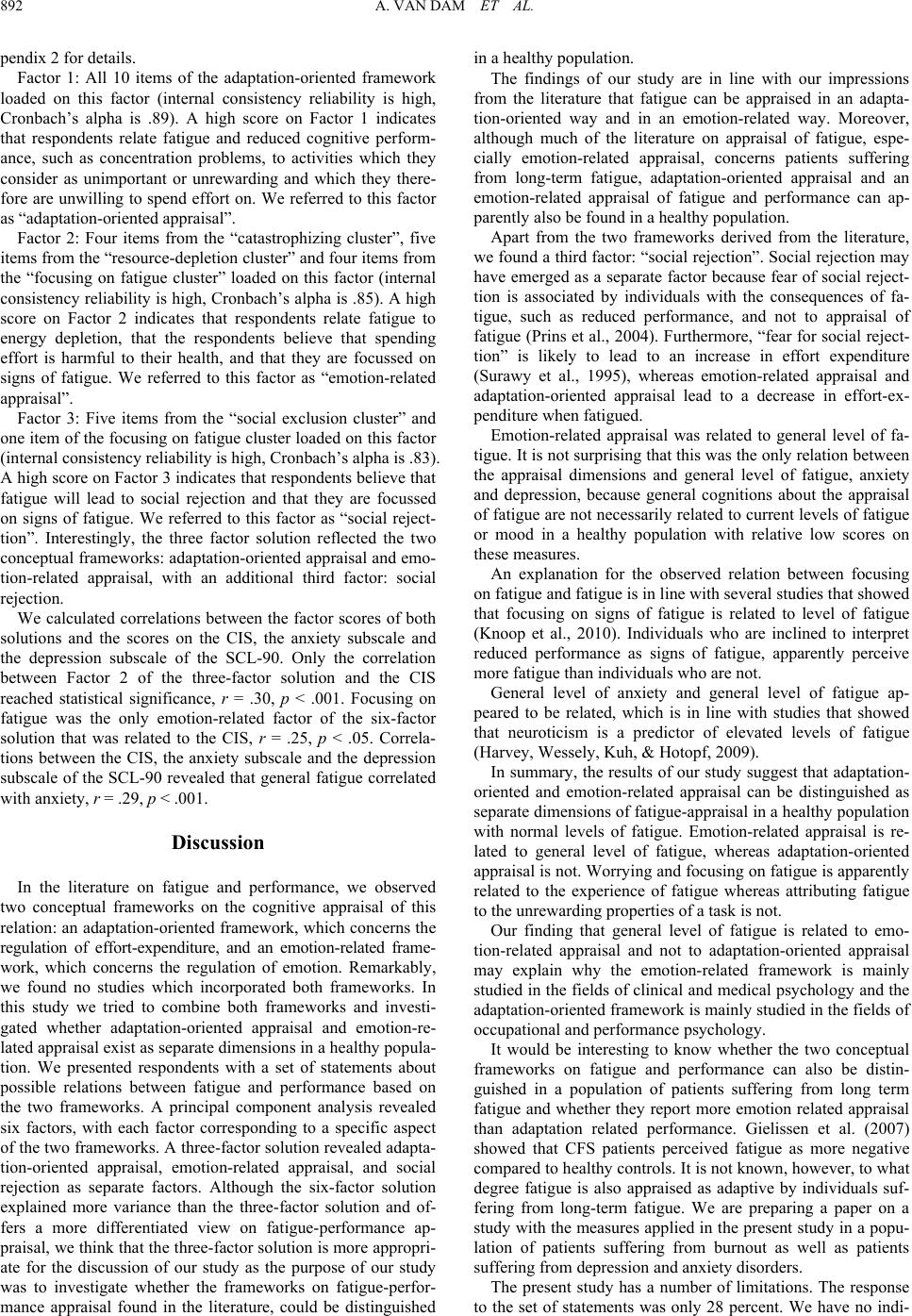 A. VAN DAM ET AL. 892 pendix 2 for details. Factor 1: All 10 items of the adaptation-oriented framework loaded on this factor (internal consistency reliability is high, Cronbach’s alpha is .89). A high score on Factor 1 indicates that respondents relate fatigue and reduced cognitive perform- ance, such as concentration problems, to activities which they consider as unimportant or unrewarding and which they there- fore are unwilling to spend effort on. We referred to this factor as “adaptation-oriented appraisal”. Factor 2: Four items from the “catastrophizing cluster”, five items from the “resource-depletion cluster” and four items from the “focusing on fatigue cluster” loaded on this factor (internal consistency reliability is high, Cronbach’s alpha is .85). A high score on Factor 2 indicates that respondents relate fatigue to energy depletion, that the respondents believe that spending effort is harmful to their health, and that they are focussed on signs of fatigue. We referred to this factor as “emotion-related appraisal”. Factor 3: Five items from the “social exclusion cluster” and one item of the focusing on fatigue cluster loaded on this factor (internal consistenc y reliability is high, Cronbach’s alpha is .83). A high score on Factor 3 indicates that respondents believe that fatigue will lead to social rejection and that they are focussed on signs of fatigue. We referred to this factor as “social reject- tion”. Interestingly, the three factor solution reflected the two conceptual frameworks: adaptation-oriented appraisal and emo- tion-related appraisal, with an additional third factor: social rejection. We calculated correlations between the factor scores of both solutions and the scores on the CIS, the anxiety subscale and the depression subscale of the SCL-90. Only the correlation between Factor 2 of the three-factor solution and the CIS reached statistical significance, r = .30, p < .001. Focusing on fatigue was the only emotion-related factor of the six-factor solution that was related to the CIS, r = .25, p < .05. Correla- tions between the CIS, the anxiety subscale and the depression subscale of the SCL-90 revealed that general fatigue correlated with anxiety, r = .29, p < .001. Discussion In the literature on fatigue and performance, we observed two conceptual frameworks on the cognitive appraisal of this relation: an adaptation-oriented framework, which concerns the regulation of effort-expenditure, and an emotion-related frame- work, which concerns the regulation of emotion. Remarkably, we found no studies which incorporated both frameworks. In this study we tried to combine both frameworks and investi- gated whether adaptation-oriented appraisal and emotion-re- lated appraisal exist as separate dimensions in a healthy popula- tion. We presented respondents with a set of statements about possible relations between fatigue and performance based on the two frameworks. A principal component analysis revealed six factors, with each factor corresponding to a specific aspect of the two frameworks. A three-factor solution revealed adapta- tion-oriented appraisal, emotion-related appraisal, and social rejection as separate factors. Although the six-factor solution explained more variance than the three-factor solution and of- fers a more differentiated view on fatigue-performance ap- praisal, we think that the three-factor solution is more appropri- ate for the discussion of our study as the purpose of our study was to investigate whether the frameworks on fatigue-perfor- mance appraisal found in the literature, could be distinguished in a healthy population. The findings of our study are in line with our impressions from the literature that fatigue can be appraised in an adapta- tion-oriented way and in an emotion-related way. Moreover, although much of the literature on appraisal of fatigue, espe- cially emotion-related appraisal, concerns patients suffering from long-term fatigue, adaptation-oriented appraisal and an emotion-related appraisal of fatigue and performance can ap- parently also be found in a healthy population. Apart from the two frameworks derived from the literature, we found a third factor: “social rejection”. Social rejection may have emerged as a separate factor because fear of social reject- tion is associated by individuals with the consequences of fa- tigue, such as reduced performance, and not to appraisal of fatigue (Prins et al., 2004). Furthermore, “fear for social reject- tion” is likely to lead to an increase in effort expenditure (Surawy et al., 1995), whereas emotion-related appraisal and adaptation-oriented appraisal lead to a decrease in effort-ex- penditure when fatigued. Emotion-related appraisal was related to general level of fa- tigue. It is not surprising that this was the only relation between the appraisal dimensions and general level of fatigue, anxiety and depression, because general cognitions about the appraisal of fatigue are not necessarily related to current levels of fatigue or mood in a healthy population with relative low scores on these measures. An explanation for the observed relation between focusing on fatigue and fatigue is in line with several studies that showed that focusing on signs of fatigue is related to level of fatigue (Knoop et al., 2010). Individuals who are inclined to interpret reduced performance as signs of fatigue, apparently perceive more fatigue than individuals who are not. General level of anxiety and general level of fatigue ap- peared to be related, which is in line with studies that showed that neuroticism is a predictor of elevated levels of fatigue (Harvey, Wessely, Kuh, & Hotopf, 2009). In summary, the results of our study suggest that adaptation- oriented and emotion-related appraisal can be distinguished as separate dimensions of fatigue-appraisal in a healthy population with normal levels of fatigue. Emotion-related appraisal is re- lated to general level of fatigue, whereas adaptation-oriented appraisal is not. Worrying and focusing on fatigue is apparently related to the experience of fatigue whereas attributing fatigue to the unrewarding properties of a task is not. Our finding that general level of fatigue is related to emo- tion-related appraisal and not to adaptation-oriented appraisal may explain why the emotion-related framework is mainly studied in the fields of clinical and medical psychology and the adaptation-oriented framework is mainly studied in the fields of occupational and performance psychology. It would be interesting to know whether the two conceptual frameworks on fatigue and performance can also be distin- guished in a population of patients suffering from long term fatigue and whether they report more emotion related appraisal than adaptation related performance. Gielissen et al. (2007) showed that CFS patients perceived fatigue as more negative compared to healthy controls. It is not known, however, to what degree fatigue is also appraised as adaptive by individuals suf- fering from long-term fatigue. We are preparing a paper on a study with the measures applied in the present study in a popu- lation of patients suffering from burnout as well as patients suffering from depression and anxiety disorders. The present study has a number of limitations. The response to the set of statements was only 28 percent. We have no indi- 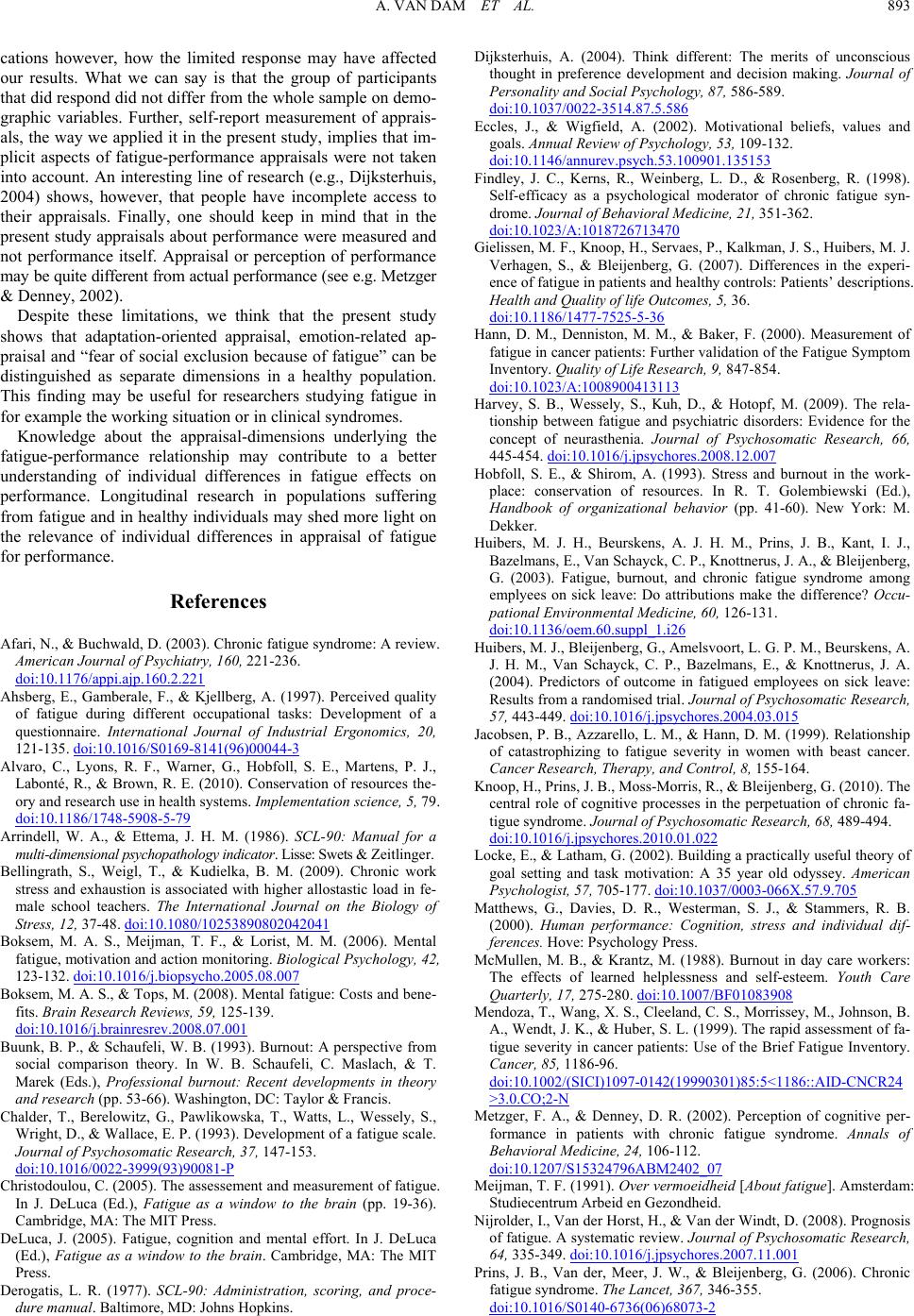 A. VAN DAM ET AL. 893 cations however, how the limited response may have affected our results. What we can say is that the group of participants that did respond did not differ from the whole sample on demo- graphic variables. Further, self-report measurement of apprais- als, the way we applied it in the present study, implies that im- plicit aspects of fatigue-performance appraisals were not taken into account. An interesting line of research (e.g., Dijksterhuis, 2004) shows, however, that people have incomplete access to their appraisals. Finally, one should keep in mind that in the present study appraisals about performance were measured and not performance itself. Appraisal or perception of performance may be quite different from actua l performance (se e e.g. Metzger & Denney, 2002). Despite these limitations, we think that the present study shows that adaptation-oriented appraisal, emotion-related ap- praisal and “fear of social exclusion because of fatigue” can be distinguished as separate dimensions in a healthy population. This finding may be useful for researchers studying fatigue in for example the working situation or in clinical syndromes. Knowledge about the appraisal-dimensions underlying the fatigue-performance relationship may contribute to a better understanding of individual differences in fatigue effects on performance. Longitudinal research in populations suffering from fatigue and in healthy individuals may shed more light on the relevance of individual differences in appraisal of fatigue for performance. References Afari, N., & Buchwald, D. (2003). Chronic fatigue syndrome: A review. American Journal of Psychiatry, 160, 221-236. doi:10.1176/appi.ajp.160.2.221 Ahsberg, E., Gamberale, F., & Kjellberg, A. (1997). Perceived quality of fatigue during different occupational tasks: Development of a questionnaire. International Journal of Industrial Ergonomics, 20, 121-135. doi:10.1016/S0169-8141(96)00044-3 Alvaro, C., Lyons, R. F., Warner, G., Hobfoll, S. E., Martens, P. J., Labonté, R., & Brown, R. E. (2010). Conservation of resources the- ory and research use in health systems. Implementation science, 5, 79. doi:10.1186/1748-5908-5-79 Arrindell, W. A., & Ettema, J. H. M. (1986). SCL-90: Manual for a multi-dimensional psychopathology indicator. L i s s e : S w e t s & Zeitlinger. Bellingrath, S., Weigl, T., & Kudielka, B. M. (2009). Chronic work stress and exhaustion is associated with higher allostastic load in fe- male school teachers. The International Journal on the Biology of Stress, 12, 37-48. doi:10.1080/10253890802042041 Boksem, M. A. S., Meijman, T. F., & Lorist, M. M. (2006). Mental fatigue, motivation and action monitoring. Biological Psychology, 42, 123-132. doi:10.1016/j.biopsycho.2005.08.007 Boksem, M. A. S., & Tops, M. (2008). Mental fatigue: Costs and bene- fits. Brain Research Reviews, 59, 125-139. doi:10.1016/j.brainresrev.2008.07.001 Buunk, B. P., & Schaufeli, W. B. (1993). Burnout: A perspective from social comparison theory. In W. B. Schaufeli, C. Maslach, & T. Marek (Eds.), Professional burnout: Recent developments in theory and research (pp. 53-66). Washington, DC: Taylor & Francis. Chalder, T., Berelowitz, G., Pawlikowska, T., Watts, L., Wessely, S., Wright, D., & Wallace, E. P. (1993). Development of a fatigue scale. Journal of Psychosomatic Re sea rch , 37, 147-153. doi:10.1016/0022-3999(93)90081-P Christodoulou, C. (2005). The assessement and measurement of fatigue. In J. DeLuca (Ed.), Fatigue as a window to the brain (pp. 19-36). Cambridge, MA: The MIT Press. DeLuca, J. (2005). Fatigue, cognition and mental effort. In J. DeLuca (Ed.), Fatigue as a window to the brain. Cambridge, MA: The MIT Press. Derogatis, L. R. (1977). SCL-90: Administration, scoring, and proce- dure manual. Baltimore, MD: Johns Hopkins. Dijksterhuis, A. (2004). Think different: The merits of unconscious thought in preference development and decision making. Journal of Personality and Social P s y chology, 87, 586-589. doi:10.1037/0022-3514.87.5.586 Eccles, J., & Wigfield, A. (2002). Motivational beliefs, values and goals. Annual Review of Psychology, 53, 109-132. doi:10.1146/annurev.psych.53.100901.135153 Findley, J. C., Kerns, R., Weinberg, L. D., & Rosenberg, R. (1998). Self-efficacy as a psychological moderator of chronic fatigue syn- drome. Journal of Behavio ral M ed ic in e, 21, 351-362. doi:10.1023/A:1018726713470 Gielissen, M. F., Knoop, H., Servaes, P., Kalkman, J. S., Huibers, M. J. Verhagen, S., & Bleijenberg, G. (2007). Differences in the experi- ence of fatigue in patients and healthy controls: Patients’ descriptions. Health and Quality of life Outcomes, 5, 36. doi:10.1186/1477-7525-5-36 Hann, D. M., Denniston, M. M., & Baker, F. (2000). Measurement of fatigue in cancer patients: Further validation of the Fatigue Symptom Inventory. Quality of Life Research, 9, 847-854. doi:10.1023/A:1008900413113 Harvey, S. B., Wessely, S., Kuh, D., & Hotopf, M. (2009). The rela- tionship between fatigue and psychiatric disorders: Evidence for the concept of neurasthenia. Journal of Psychosomatic Research, 66, 445-454. doi:10.1016/j.jpsychores.2008.12.007 Hobfoll, S. E., & Shirom, A. (1993). Stress and burnout in the work- place: conservation of resources. In R. T. Golembiewski (Ed.), Handbook of organizational behavior (pp. 41-60). New York: M. Dekker. Huibers, M. J. H., Beurskens, A. J. H. M., Prins, J. B., Kant, I. J., Bazelmans, E., Van Schayck, C. P., Knottnerus, J. A., & Bleijenberg, G. (2003). Fatigue, burnout, and chronic fatigue syndrome among emplyees on sick leave: Do attributions make the difference? Occu- pational Environmental Med i c ine, 60, 126-131. doi:10.1136/oem.60.suppl_1.i26 Huibers, M. J., Bleijenberg, G., Amelsvoort, L. G. P. M., Beurskens, A. J. H. M., Van Schayck, C. P., Bazelmans, E., & Knottnerus, J. A. (2004). Predictors of outcome in fatigued employees on sick leave: Results from a randomised trial. Journal of Psychosomatic Research, 57, 443-449. doi:10.1016/j.jpsychores.2004.03.015 Jacobsen, P. B., Azzarello, L. M., & Hann, D. M. (1999). Relationship of catastrophizing to fatigue severity in women with beast cancer. Cancer Research, Therapy, and Control, 8, 155-164. Knoop, H., Prins, J. B., Moss-Morris, R., & Bleijenberg, G. (2010). The central role of cognitive processes in the perpetuation of chronic fa- tigue syndrome. Journal of Psychosomatic Research, 68, 489-494. doi:10.1016/j.jpsychores.2010.01.022 Locke, E., & Latham, G. (2002). Building a practically useful theory of goal setting and task motivation: A 35 year old odyssey. American Psychologist, 57, 705-177. doi:10.1037/0003-066X.57.9.705 Matthews, G., Davies, D. R., Westerman, S. J., & Stammers, R. B. (2000). Human performance: Cognition, stress and individual dif- ferences. Hove: Psychol og y Press. McMullen, M. B., & Krantz, M. (1988). Burnout in day care workers: The effects of learned helplessness and self-esteem. Youth Care Quarterly, 17, 275-280. doi:10.1007/BF01083908 Mendoza, T., Wang, X. S., Cleeland, C. S., Morrissey, M., Johnson, B. A., Wendt, J. K., & Huber, S. L. (1999). The rapid assessment of fa- tigue severity in cancer patients: Use of the Brief Fatigue Inventory. Cancer, 85, 1186-96. doi:10.1002/(SICI)1097-0142(19990301)85:5<1186::AID-CNCR24 >3.0.CO;2-N Metzger, F. A., & Denney, D. R. (2002). Perception of cognitive per- formance in patients with chronic fatigue syndrome. Annals of Behavioral Medicine, 24, 106-112. doi:10.1207/S15324796ABM2402_07 Meijman, T. F. (1991). Over vermoeidheid [About fatigue]. Amsterdam: Studiecentrum Arbe id en Gezondheid. Nijrolder, I., Van der Horst, H., & Van der Windt, D. (2008). Prognosis of fatigue. A systematic review. Journal of Psychosomatic Research, 64, 335-349. doi:10.1016/j.jpsychores.2007.11.001 Prins, J. B., Van der, Meer, J. W., & Bleijenberg, G. (2006). Chronic fatigue syndrome. The Lancet, 367, 346-355. doi:10.1016/S0140-6736(06)68073-2 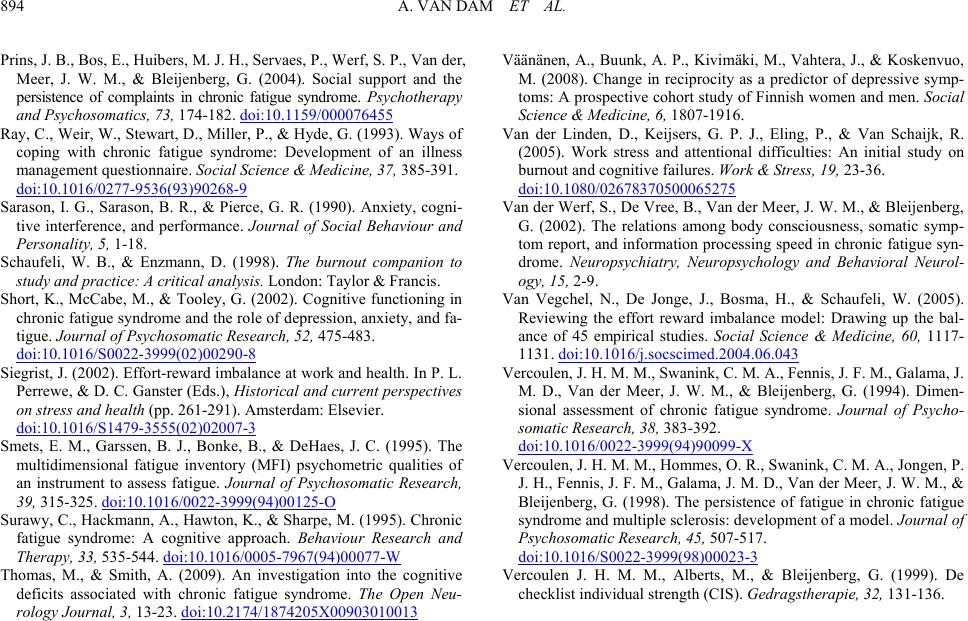 A. VAN DAM ET AL. 894 Prins, J. B., Bos, E ., Hu ibers, M. J. H., Serv aes, P. , Werf, S. P., Van der, Meer, J. W. M., & Bleijenberg, G. (2004). Social support and the persistence of complaints in chronic fatigue syndrome. Psychotherapy and Psychosomatics, 73, 174-182. doi:10.1159/000076455 Ray, C., Weir, W., Stewart, D., Miller, P., & Hyde, G. (1993). Ways of coping with chronic fatigue syndrome: Development of an illness management questionnaire. Social Science & Medicine, 37, 385-391. doi:10.1016/0277-9536(93)90268-9 Sarason, I. G., Sarason, B. R., & Pierce, G. R. (1990). Anxiety, cogni- tive interference, and performance. Journal of Social Behaviour and Personality, 5, 1-18. Schaufeli, W. B., & Enzmann, D. (1998). The burnout companion to study and practice: A critical analysis. London: Taylor & Francis. Short, K., McCabe, M., & Tooley, G. (2002). Cognitive functioning in chronic fatigue syndrome and the role of depression, anxiety, and fa- tigue. Journal of Psychosoma ti c Research, 52, 475-483. doi:10.1016/S0022-3999(02)00290-8 Siegrist, J. (2002). Effort-reward imbalance at work and health. In P. L. Perrewe, & D. C. Ganster (Eds.) , Historical and current perspectives on stress and health (pp. 26 1-291). Amster dam: Elsevier. doi:10.1016/S1479-3555(02)02007-3 Smets, E. M., Garssen, B. J., Bonke, B., & DeHaes, J. C. (1995). The multidimensional fatigue inventory (MFI) psychometric qualities of an instrument to assess fatigue. Journal of Psychosomatic Research, 39, 315-325. doi:10.1016/0022-3999(94)00125-O Surawy, C., Hackmann, A., Hawton, K., & Sharpe, M. (1995). Chronic fatigue syndrome: A cognitive approach. Behaviour Research and Therapy, 33, 535-544. doi:10.1016/0005-7967(94)00077-W Thomas, M., & Smith, A. (2009). An investigation into the cognitive deficits associated with chronic fatigue syndrome. The Open Neu- rology Journal, 3, 13-23. doi:10.2174/1874205X00903010013 Väänänen, A., Buunk, A. P., Kivimäki, M., Vahtera, J., & Koskenvuo, M. (2008). Change in reciprocity as a predictor of depressive symp- toms: A prospective cohort study of Finnish women and men. Social Science & Medicine, 6, 1807-1916. Van der Linden, D., Keijsers, G. P. J., Eling, P., & Van Schaijk, R. (2005). Work stress and attentional difficulties: An initial study on burnout and cognitive failures. Work & Stress, 19, 23-36. doi:10.1080/02678370500065275 Van der Werf, S., De Vree, B., Van der Me er, J. W. M., & Bleij enberg , G. (2002). The relations among body consciousness, somatic symp- tom report, and information processing speed in chronic fatigue syn- drome. Neuropsychiatry, Neuropsychology and Behavioral Neurol- ogy, 15, 2-9. Van Vegchel, N., De Jonge, J., Bosma, H., & Schaufeli, W. (2005). Reviewing the effort reward imbalance model: Drawing up the bal- ance of 45 empirical studies. Social Science & Medicine, 60, 1117- 1131. doi:10.1016/j.socscimed.2004.06.043 Vercoulen, J. H. M. M., Swanink, C. M. A., Fennis, J. F. M., Galama, J. M. D., Van der Meer, J. W. M., & Bleijenberg, G. (1994). Dimen- sional assessment of chronic fatigue syndrome. Journal of Psycho- somatic Research, 38, 383-392. doi:10.1016/0022-3999(94)90099-X Vercoulen, J. H. M. M., Hommes, O. R., Swanink, C. M. A., Jongen, P. J. H., Fennis, J. F. M., Galama, J. M. D., Van der Meer, J. W. M., & Bleijenberg, G. (1998). The persistence of fatigue in chronic fatigue syndrome and multiple sclerosis: development of a model. Journal of Psychosomatic Research, 45, 507-517. doi:10.1016/S0022-3999(98)00023-3 Vercoulen J. H. M. M., Alberts, M., & Bleijenberg, G. (1999). De checklist individual strength (CIS). Gedragsther ap ie, 32, 131-136. 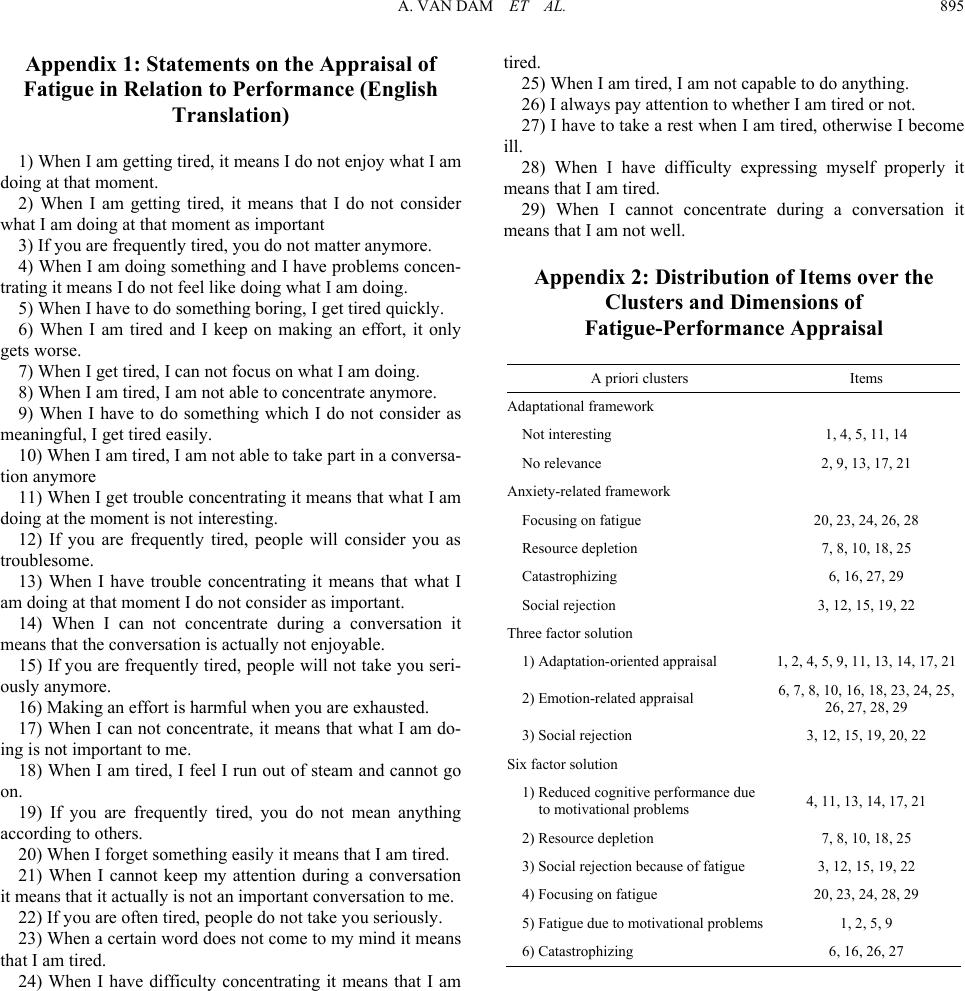 A. VAN DAM ET AL. 895 Appendix 1: Statements on the Appraisal of Fatigue in Relation to Performance (English Translation) 1) When I am getting tired, it means I do not enjoy what I am doing at that moment. 2) When I am getting tired, it means that I do not consider what I am doing at that moment as important 3) If you are frequently tired, you do not matter anymore. 4) When I am doing something and I have problems concen- trating it means I do not feel like doing what I am doing. 5) When I have to do something boring, I get tired quickly. 6) When I am tired and I keep on making an effort, it only gets worse. 7) When I get tired, I can not focus on what I am doing. 8) When I am tired, I am not able to concentrate anymore. 9) When I have to do something which I do not consider as meaningful, I get tired easily. 10) When I am tired, I am not able to take part in a conversa- tion anymore 11) When I get trouble concentrating it means that what I am doing at the moment is not interesting. 12) If you are frequently tired, people will consider you as troublesome. 13) When I have trouble concentrating it means that what I am doing at that moment I do not consider as important. 14) When I can not concentrate during a conversation it means that the convers ation is actually no t enjoyable. 15) If you are frequently tired, people will not take you seri- ously anymore. 16) Making an effo rt is harmful when you ar e exhausted. 17) When I can not concentrate, it means that what I am do- ing is not important to me. 18) When I am tired, I feel I run out of steam and cannot go on. 19) If you are frequently tired, you do not mean anything according to others. 20) When I forget something easily it means that I am tired. 21) When I cannot keep my attention during a conversation it means that it actually is not an importan t conversation to me. 22) If you are ofte n tired, people do not t a ke you seriously. 23) When a certain word does not come to my mind it means that I am tired. 24) When I have difficulty concentrating it means that I am tired. 25) When I am tired, I am not capable to do anything. 26) I always pay attention to whether I am tired or not. 27) I have to take a rest when I am tired, otherwise I become ill. 28) When I have difficulty expressing myself properly it means that I am tired. 29) When I cannot concentrate during a conversation it means that I am not well. Appendix 2: Distribution of Items over the Clusters and Dimensions of Fatigue-Performance Appraisal A priori clusters Items Adaptational framework Not interesting 1, 4, 5, 11, 14 No relevance 2, 9, 13, 17, 21 Anxiety-rela ted framework Focusing on fatigue 20, 23, 24, 26, 28 Resource depletion 7, 8, 10, 18, 25 Catastroph i zing 6, 16, 27, 29 Social reje ction 3, 12, 15, 19, 22 Three factor solution 1) Adaptati o n-oriented appraisal 1, 2, 4, 5, 9, 11, 13, 14, 17, 21 2) Emotion-re l ated appraisal 6, 7, 8, 10, 16, 18, 23, 24, 25, 26, 27, 28, 2 9 3) Social rejection 3, 12, 15, 19, 20, 22 Six factor solution 1) Reduced cognitive pe r for mance due to motivational problems 4, 11, 13, 14, 17, 21 2) Resourc e depletion 7, 8, 10, 18, 25 3) Social rejection because of fatigue 3, 12, 15, 19, 22 4) Focusing on fatigue 20, 23, 24, 28, 29 5) Fatigue due to motivational problems 1, 2, 5, 9 6) Catastro p hizing 6, 16, 26, 27
|